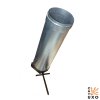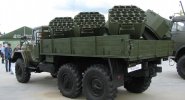https://mil.in.ua/uk/blogs/skilky-tankiv-zalyshylos-u-rosiyi/
January 10, 2024
How many tanks are left in Russia?
Armored vehicles Russia
How many tanks are left in Russia? A question that comes up very often in discussions, and to which it is simply impossible to find an exact answer - probably even Shoigu and Gerasimov do not know it. However, attempts to count tanks do not stop. Today we will analyze one of them - the report of the French OSINT cell ARI, published on August 31, 2023.
The French tried to figure out how many tanks the Russians have at storage bases. It must be said that the numbers here are very "jumping" - for example, the International Institute for Strategic Studies estimated this number in 2022 at as many as 17.5 thousand tanks, including 200 T-90, 3 thousand T-80, 7 thousand T- 72, 2 thousand T-64, 2.5 thousand T-62 and 2.8 thousand T-55. However, these calculations are very inaccurate, because they are based on the estimate of the number of tanks produced during the USSR.
Estimates from last year's Military Balance yearbook are much more modest: approximately 2,000 tanks in service and up to 5,000 in storage. However, its authors take into account models from the T-62 and higher - but in reality, the foot-footed not only have hundreds of T-54/55 in warehouses, but are already using them at the front! It is interesting that in 2022, Military Balance wrote about as many as 13.7 thousand Russian tanks, but even in this case it did not count the T-54/55.
In their calculations, ARI specialists used satellite images taken between April and September 2021. They were supplemented with information from social networks. Calculations were made for ten central storage bases out of 22 available in the Russian Federation - they are the ones where, according to estimates, 95% of tanks are concentrated.
So, what did you manage to calculate? 5,538 tanks, of which 4,347 are identified by type. It is clear that we are talking about tanks that are stored under the open sky. There are also canopies and boxes at the researched bases, the capacity of which is estimated at 1,950 cars. However, part of these premises must be allocated for repairs, and part is probably occupied not by tanks, but by other machines. Taking into account the above, the number of tanks in storage can be estimated at a maximum of 7,000, but probably around 6,000.

What types have been identified? These are 750 T-80 tanks (mainly BV and UD versions), 1,945 T-72 (mostly non-modernized T-72B, as well as T-72A and T-72), 1,239 T-62 (including many T -62M) and 413 T-54/55. Three quarters of them are tanks produced before 1980. The situation with the T-64 is a little unclear - the French write that they did not count them, because due to the lack of spare parts, these tanks will not be able to be returned to service. There are no T-90s either - although there should be some amount of them at the storage bases, after all. Maybe they were counted together with the T-72?
The breakdown of types of tanks by district is also interesting. In the Western Military District, these are T-80U/UE-1, T-80BV, T-80UD and T-72. In Central - older T-72 and remnants of T-64. In the East - some T-80, the bulk of T-62, as well as T-54/55.
Attention was also drawn to the tank repair capabilities of the Russian Federation. Currently, 10 large military equipment repair factories are operating across the country, two of which are deployed from repair bases. Three of them repair tanks. To this should be added "Omsktransmash", which used to manufacture T-80 tanks, and now repairs them and modernizes them to the level of T-80BVM.
The pace of work, according to ARI , is significantly lower than Russian propaganda says. For example, the 103rd Armored Tank Repair Plant in Transbaikalia is able to restore an average of 8 T-62 tanks every month: at the beginning of March 2023, the army handed over about 40 such tanks, the repair of which began in October 2022. At the same time, Russian publications talk about the monthly repair of 22-23 tanks here.
The 61st armored personnel carrier in St. Leninburg repairs 30-60 tanks a year. The 163rd armored personnel carrier (Krasnodar Territory), implementing previously concluded contracts, repaired 24 T-72 tanks and 100 BMP-2 tanks in one year (apparently 2021?). The situation at Omsktransmash is illustrated by satellite photos: in November 2022, there were about 100 tanks awaiting repair; in May 2023, the queue almost doubled. The recovery time of one tank raised from the storage base is very dependent on its preservation. For cars in worse condition, it reaches three to four months. Often, for recovery, you have to resort to cannibalizing other machines.
"Uralvagonzavod" in 2011-2021 modernized about 1,240 T-72B tanks to the T-72B3M standard (and derivatives). However, in 2021, the pace of modernization has significantly decreased - ARI considers this to be a consequence of the depletion of T-72B tanks that are subject to renewal. In the peak period, up to 300 tanks were modernized per year, then this number decreased to 120, and now it has dropped to zero. Instead, "Uralvagonzavod" focused on the production of T-90M, and to a large extent not new, but modernized from previous modifications of T-90.

According to ARI estimates, the Russian industry is able to produce about 390 tanks a year, including new, modernized and restored from storage bases. Russian sources call the numbers 700-800 tanks in 2022 and even 1,500 in 2023. At the same time, due to the sanctions, the quality of products is falling: those tanks that return to service must be equipped with thermal imagers, the parameters of which are close to those of the Cold War era devices.
At the time of the start of the full-scale aggression against Ukraine, the Russians had 2,987 tanks in service. According to data from Oryx, losses as of the beginning of 2024 amount to 2,619 tanks - 1,725 destroyed, 145 damaged, 205 abandoned and 544 lost. In fact, this number is even higher, because not all losses fall on the oryx. In this situation, according to ARI experts, the only option for the development of events in 2024 for the Russian Federation is only prolonged stagnation at the front. This will make it possible to form a powerful tank fist - taking into account the prospects of increasing the annual output of T-90M at Uralvagonzavod to 250-300 machines and plans to resume production of T-80 at Omsktransmash. Other scenarios – preservation of the current nature of the hostilities or a successful Ukrainian offensive – will lead to further "shredding" of the aggressor's tank fleet.
-
Andriy Haruk
Military historian, doctor of historical sciences, professor of the Department of Humanities at the National Academy of Land Forces named after Hetman Petro Sahaidachny





 , ja tuskin tarvitsee epäillä, etteikö ajattelisi yhä samoin...
, ja tuskin tarvitsee epäillä, etteikö ajattelisi yhä samoin...
